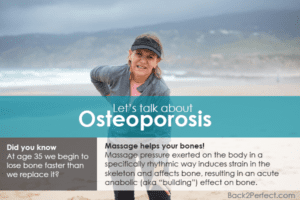Massage Therapy Can Help!
by Elena Vasell
 Osteoporosis has been quite a popular topic in the last two months at Back 2 Perfect. Recently a client asked me if massage can help with bone density, so it might be helpful to talk about massage and its role in the presence of osteoporosis.
Osteoporosis has been quite a popular topic in the last two months at Back 2 Perfect. Recently a client asked me if massage can help with bone density, so it might be helpful to talk about massage and its role in the presence of osteoporosis.
Bone growth and maintenance is a carefully coordinated dance between adding to our bone mass and subtracting from it. The minerals we use in daily activities are replaced by what we take in through our diet, and turnover occurs in lengthy, predictable cycles. It is a balancing act guided by our moment-to-moment needs, and it also is the essence of Wolff’s Law: bones adapt according to mechanical loading. Just like muscles do, bones become stronger with demand, and in the absence of mechanical stress, they demineralize and get weaker.
Somewhere around age 30–35, the balance between increasing and decreasing bone mass shifts and we begin to lose bone faster than we replace it. At that point, we can work to maintain bone density with proper nutrition and weight bearing exercises, but we can’t usually increase it. As we age, losses accelerate. Changes develop faster in trabecular bone than in cortical bone, which is problematic because trabecular, or “spongy,” bone is more porous to begin with, so it has less mineral matter to give up. Our “hip bones” and vertebrae are made of trabecular bone, and this is important to know because they have an important structural function in our bodies.
As a certified massage therapist, I know that massage therapy can help!
In a 2013 clinical trial of 48 postmenopausal women, a markedly higher metabolic marker for bone growth activity was found in the participants who received massage. This trial proved that massage pressure exerted on the body in a specifically rhythmic way induces strain in the skeleton and affects bone, similar to other means of applying mechanical load, and this results in an acute anabolic (aka “building”) effect on bone.
For those clients with established osteoporosis and accompanying muscle tension around the specifically affected areas, massage therapy can reduce pain, improve range of motion, facilitate the flow of fluids, blood, and nutrients, and even keep inflammation levels lower (aka less bursitis pain).
Massage can also help increase awareness of postural habits and self-care practices that might help a client avoid the worst of osteoporosis outcomes later in life. While improving forward shoulder rolling or head-forward patterns doesn’t improve bone density, it can promote muscular patterns that decrease dysfunction and pain. Additionally, limited data shows that massage can improve balance, which can offer better protection against falls.
Safety is of utmost importance for us as at Back 2 Perfect, and with a diagnosis of osteoporosis any kind of bodywork that might compress bones and cause unnecessary excess pressure is to be avoided. Gentler massage modalities, like ‘effleurage’, need to be applied, and special attention is taken around vertebrae, femoral bone, pelvis, ribs, forearms, and wrists. So, even if the client might seek deep massage to help with muscle pain, that pressure will be given with an angle and direction that does not directly compress underlying bones.
Rest assured that massage with the condition of osteoporosis can be not only safe, but supportive and healing. Make sure you discuss your symptoms and concerns with your massage therapist, so we can take the safest precautions and provide the needed accommodations for your massage!
So, come give your bones some care at Back 2 Perfect See you soon!
You can book a MEDICAL MASSAGE with focus on Osteoporosis here. (Be sure to explain to your therapist that you want to focus on your bones.)
